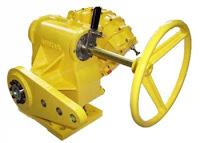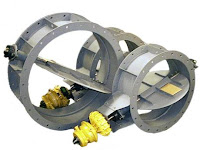The rotary vane actuator design is based upon a single moving part which eliminates
additional parts required to convert linear motion to rotary motion.
This simple and innovative design provides a highly accurate and
extremely reliable actuator for operating valves, drives and dampers,
and is perfectly suited for the most demanding process control control
applications.
The Kinetrol rotary vane design is based upon a single moving part which eliminates additional parts required to convert linear motion to rotary motion. This simple and innovative design provides a highly accurate and extremely reliable actuator for operating valves, drives and dampers, and is perfectly suited for the most demanding process control applications. For more information visit www.kinetrolusa.com or call 972-447-9443.
Why Vane Actuators Are Better - We'll Make This Easy
With millions of actuators performing reliably around the world, the Kinetrol vane actuators' outstanding cycle life, smooth and precise movement, and environmentally rugged design makes it the best choice for all of your valve actuation needs.
Choosing the Right Valve Actuator for Pulp & Paper Processing
In pulp and paper mills there are many hazardous, corrosive and reactive chemicals used in the chemical pulping process. This particularly hostile atmosphere demands properly engineered automated valve systems and ruggedized valve actuators, spring units, and positioners.
If you understand the basics of how paper is made, and what chemicals are normally found in the environment, you'll understand immediately why special attention needs to be taken for valve and actuator selection.
In the early stage of paper production, during the separation of pulp from wood chips, digesters combine high heat and a strong alkaline liquid called "white liquor" to turn wood chips into pulp. The white liquor breaks down the lignin (the material that holds the wood fiber together) in wood chips and mixes with the white liquor to form a by-product referred to as "black liquor". Another by-product of this process is Hydrogen Sulfide, a poisonous, corrosive, and flammable gas.
 |
| 8" valve on a green liquor line with Kinetrol Model 14 |
Black liquor is then sent to recovery boilers where molten solids - namely Sodium Sulfide, Sodium Carbonate - are formed. These molten solids are sent to tanks and mixed with water to become "green liquor".
While this phase of the process presents challenges to valve and actuator selection, the use of and exposure to harsh chemicals and compounds is not limited to the wood chip/pulp separation stage.
Later in the paper production process, the pulp is washed, screened and bleached. During this phase, valve actuators are exposed to atmospheres containing many other aggressive compounds such as Oxygen Chlorine, Hydrogen Peroxide, and Ozone.
Proper selection of valves and actuators is critical for worker safety, plant safety, and for the quality of the paper production. All components - valves, actuators, spring units, and positioners - need to be carefully selected to provide safe operation, redundancy, optimum control, and optimal service life.
Kinetrol products are designed for just such service and have an outstanding reputation in these applications. To find out how and why, visit http://www.kinetrolusa.com or call 972-447-9443.
Kinetrol products are designed for just such service and have an outstanding reputation in these applications. To find out how and why, visit http://www.kinetrolusa.com or call 972-447-9443.
Kinetrol Product Line Video
A short overview of the Kinetrol product line.
For over 50 years Kinetrol has been providing trouble-free valve and damper actuators to the chemical, biofuel, food & beverage, metal, mineral, oil, gas, pharmaceutical, power generation, paper, textile, water, wastewater, and transportation industries.
For over 50 years Kinetrol has been providing trouble-free valve and damper actuators to the chemical, biofuel, food & beverage, metal, mineral, oil, gas, pharmaceutical, power generation, paper, textile, water, wastewater, and transportation industries.
Pneumatic Actuators Designed to Handle Food Processing Wash Down
 |
| Self-foaming, caustic cleaners are applied to everything in the room. |
Many plants operate two 8-hour shifts, and reserve a third shift for a meticulous cleaning. During the cleaning shift, all equipment is locked out and tagged for safety, and then disassembled to provide access to all the small "nooks and crannies" where food and bacteria can hide. The next step involves a pre-rinse where any visible product debris is removed with hot water. Up next is the soap and scrub phase, where self-foaming general purpose cleaners are applied on all the equipment, walls, floors and drains of the production facility and then scrubbed with brushes and sponges.
It’s important to note that everything in the room is washed with these caustic and/or acidic cleaners.
The next step is typically another hot water wash-down, followed by careful visual inspections using flashlights to ensure all debris has been removed. The equipment is then re-assembled and swabbed with bioluminescence agents that glow when potential problem areas are found. Many processors go one step further and include a final step where they again flood the equipment, walls, and floor with cool water and more caustic sanitizer.
 |
| Kinetrol Blueline for foodservice applications. |
Recently, Kinetrol introduced it's new “Blueline” pneumatic actuator which was tested and meets the requirements of 21 CFR 175.300. This new actuator stands up to the wash down chemicals used in plant cleaning making them available for use in areas where other pneumatic actuators are not approved, or simply can not stand up to the environment.
The Blueline Series provides food and beverage processors all the time-proven benefits of the Kinetrol PLUS provides an affordable option for tough chemical wash-down areas. For more information, visit Kinetrol USA's website or call 972-447-9443.
Boiler Damper Drives: Pneumatic Vane Actuators Excel
 |
| Damper drive with pneumatic vane actuator (Kinetrol). |
 |
| Damper drive (side mount) installed. |
 |
| Damper drives on round dampers. |
- Precise, smooth signal to movement response
- 100 percent duty cycle
- Continuous modulating service
- No overheating
- High speed/high-torque
- Fast full stroke open/close
- Very easily serviced
- Excels in harsh, high-temperature operating environments
- Effectively zero air consumption in resting state
Lower Total-Cost-of-Ownership in Poor Process Environments with Pneumatic Vane Actuators
 |
| Design advantages for use in poor process conditions (click for larger view). |
For the operation of pneumatically controlled valves, and as a better alternative to rack and pinion actuators, Kinetrol rotary vane actuators are an excellent choice. Their simple design, with one moving part, and an elegantly engineered vane, inherently protects the actuator from bad instrument air. Kinetrol's use of double opposed polyurethane lip seals, backed by stainless steel expanders, ensure long-term lip seal contact and effective sealing for years of maintenance free life. The vane, lip seals, and expanders actually provide a self-cleaning, or wiping, mechanism for any moisture, dirt or dust entering the interior of the actuator. In effect, the vane actuator's design "sweeps away" the debris that will cause other actuators to fail.
A considerable cost savings can be calculated given the trouble-free performance Kinetrol vane actuators provide. Assuming both a Kinetrol and standard rack and pinion actuator cost approximately the same, and that the life of a typical rack and pinion actuator in these environments is approximately 1 year, you can easily see the savings. By factoring in the replacement cost for an new actuator, and the cost of labor to install, you’ll find a standard rack and pinion is at least 2.5x the cost of Kinetrol over a 2 year period.
Kinetrol actuators have a well-earned reputation for operating trouble-free for years in the most difficult environments. Considering their years of maintenance-free service, it’s easy to understand the significantly lower total-cost-of-ownership they deliver.
For more information, visit Kinetrol USA at http://www.kinetrolusa.com or call 972-447-9443.
Rugged Design Makes This Vane Actuator the Best Choice for Any Valve or Damper Automation Job
Watch the video below for a quick understanding of why Kinetrol Vane Actuators provide the longest service life in the toughest valve and damper applications.
Subscribe to:
Posts (Atom)
